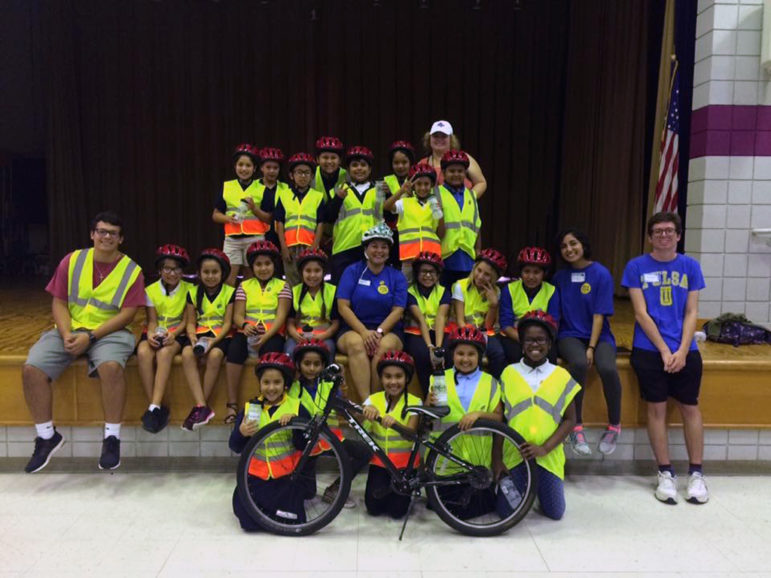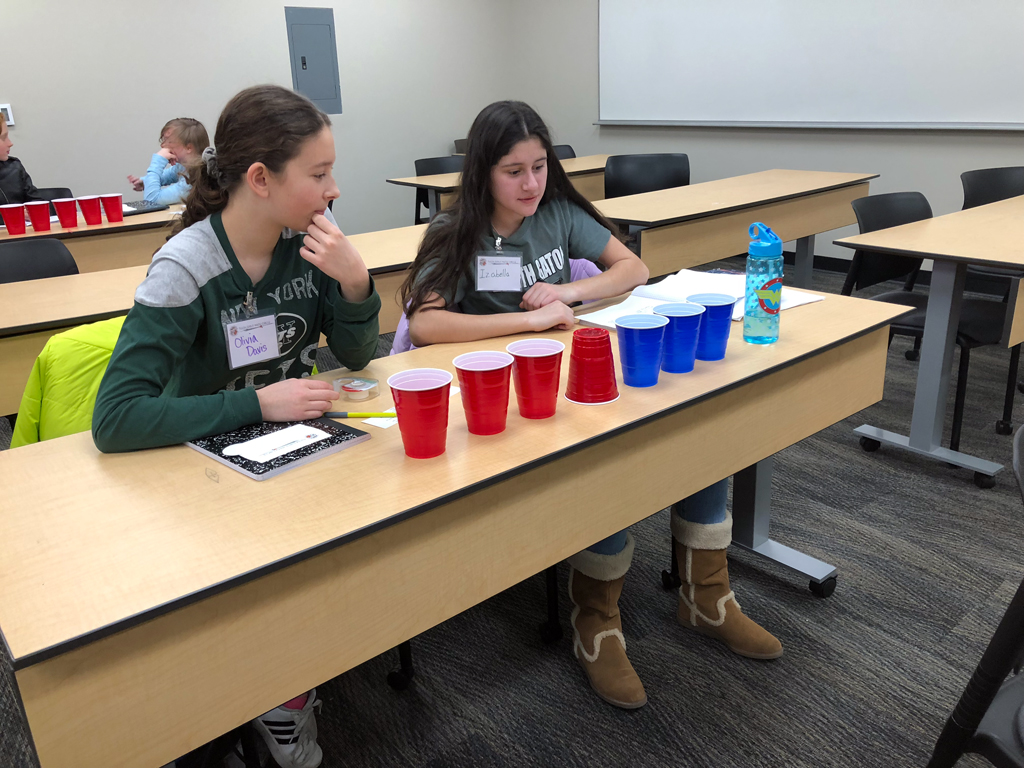In a classroom at the University of Tulsa in Oklahoma, a group of middle school girls play a game with plastic cups lined up on a table.
The girls turn the cups in a sequence, trying to get them all right side up.
“It’s never going to be even. No, never!” shouts one in exasperation.
Later on, the girls switch to another math-related game.
“We were doing something with infinity,” recalled Donna Farrior, the University of Tulsa visiting associate professor who leads the group.
Farrior noticed one girl with her head in her hands, apparently very discouraged.
But then the girl exclaimed: “I get it, I get it! My mind’s just blown!”
The mind-blowing experience — along with the thrill of victory and the agony of defeat — occurred in the Tulsa Girls’ Math Circle, a university-run program serving up to 40 girls each quarter. Professors and math majors volunteer with the group.
Here, girls from private schools and underserved public schools intermingle to play with math problems to learn the fun of figuring things out.
“We think middle school is where we lose kids,” Farrior said. “We really see girls drop out of math after middle school.”
The goal is to “build them up and give them a running start.”
It’s just one of several University of Tulsa’s community engagement programs that reach out to youth. The University of Tulsa, through True Blue Neighbors, stretches a little further than some universities and impacts the lives of many youth well before they reach college age.
Outside the doors of the university
Over at Kendall-Whittier Elementary School, just across the street from the university campus, kids are taking home Chromebooks from a university-sponsored after-school program. Their parents have received free internet connections from Cox Communications and come in once a month to learn new internet skills.
University students volunteer as mentors in the school. A free behavioral health clinic run by the psychology department prioritizes residents of the Kendall-Whittier neighborhood. And a legal rights clinic for immigrants is offered free by the law school.
These extensive outreach activities are coordinated through the university’s True Blue Neighbors Center for Community Engagement. Many of them focus on this neighborhood.
“The need is so high there,” said Danielle Hovenga, director of True Blue Neighbors. More than 40 percent of neighborhood residents live in poverty. The majority of children in the Kendall-Whittier Neighborhood are not doing well academically, according to the Community Action Project of Tulsa County, an anti-poverty agency that received a federal Promise Neighborhood grant for the area. Many drop out of high school, and food insecurity is a problem.
Nevertheless, “it’s a very beautiful, culturally rich neighborhood with a high Hispanic population,” Hovenga said. “It’s really seen a lot of revitalization.”
Sweatshirts, bikes and laptops
During the Great Recession, the University of Tulsa took a look at itself and the economic hardship that surrounded it, Hovenga said. It brought together existing outreach programs and began to create new ones to address challenges in the community.
It contacted Kendall-Whittier Elementary, a 900-student Title I school where 43 percent of kids are English language learners. Among the earliest actions was to provide sweatshirts for kids because not all had coats suitable for cold weather. The university also provided books, funded field trips and began sending university student volunteers to the school.
The university applied for a federal 21st Century Community Learning Center grant to operate an after-school program and four-week summer program known as the True Blue Neighbors Youth Mentoring Program. This after-school program now serves 140 students, 16 percent of the Kendall-Whittier Elementary population.

A 21st Century after-school program, the True Blue Neighbors Youth Mentoring Program, offers bike riding among its many activities. Partnerships with Tulsa Hub, Cox Communications, Reading Partners and others enrich the program offerings.
The program sparked partnerships that brought in more resources, Hovenga said. An important function of True Blue Neighbors is to build relationships with nonprofits, government agencies, businesses and other organizations to help meet community needs, she said.
In 2015, Cox Communications began providing laptops to kids and families in a project to see whether digital access would improve academic performance.
“Many of our [Kendall-Whittier] families had not had laptops or consistent digital access,” Hovenga said. Today, 140 students have the laptops and nearly 90 families have internet through the program.
The Cox project highlighted some barriers, Hovenga said. For example, not every house had adequate electrical outlets, she said. Now some families for the first time are able to email teachers and access the school’s online student information system.
Preliminary data in the 2016-17 school year showed that third-graders in the Cox project scored significantly higher on reading tests than other students in the after-school program, and even higher compared with all the school’s third-graders.
Kids in the after-school program have other opportunities, too. They can ride bikes, for example. Tulsa Hub sponsors a once-a-week bike club, providing the bikes as well as riding and safety instruction, said Olivia Landrum, director of the after-school program.
“Most of our kids don’t know how to ride a bike,” she said.
The Tulsa Regional STEM Alliance provides math mentors, Fab Lab Tulsa provides hands-on science learning, and the Tulsa Debate League engages fifth- and sixth-graders in debate after school, she said.
About 160 volunteers from the University of Tulsa have consistently worked with kids through Reading Partners, Hovenga said. The national nonprofit works with kids in grades K-2 to help them read at grade level.
Engaging students and faculty
University students also organized a mentoring program at nearby Will Rogers College Junior and Senior High School. That program is no longer active, however, since student leadership has changed.
Each college at the University of Tulsa has an outreach program. The math department sponsors the Tulsa Girls Math Circle, which serves girls throughout the city. Engineering students work with the Little Light House, which serves kids with developmental and physical disabilities. College students develop adaptive technologies to support the kids in their daily activities.
A Spanish professor requires her upper-level students to volunteer at the Kendall-Whittier after-school program to get practice speaking Spanish with the kids.
The psychology department runs the True Blue Neighbors Behavioral Health Clinic, which offers therapy at no cost. Schoolchildren are also referred there for assessments to clarify the underlying cause of learning issues. The clinic, staffed with graduate students and doctoral candidates and in the Kendall-Whittier neighborhood, gives priority to those residents.
The need for services is great, especially since Oklahoma made cuts in mental health funding, Hovenga said.
The College of Law offers the Boesche Legal Clinic, which trains attorneys and provides legal help on immigration issues. Law students get practical experience there.
Students, faculty and the university as a whole benefit from True Blue Neighbors, Hovenga said.
Students “get a really valuable real-world experience that will shape who they are,” she said.
Some have changed their majors after becoming mentors at Kendall-Whittier Elementary, for example, she said, citing one who switched from business to education.
Students become “engaged citizens” as a result of their volunteer work, she said.
And the youth they serve are drawn into the university’s orbit. Girls in the Tulsa Girls Math Circle may not have been on a college campus before, Hovenga said.
“It may be a turning point for some of the girls,” she said.




























